
Copepods are a group of small crustaceans found in nearly every freshwater and saltwater habitat. Some species are planktonic, some are benthic, a number of species have parasitic phases, and some continental species may live in limnoterrestrial habitats and other wet terrestrial places, such as swamps, under leaf fall in wet forests, bogs, springs, ephemeral ponds, and puddles, damp moss, or water-filled recesses (phytotelmata) of plants such as bromeliads and pitcher plants. Many live underground in marine and freshwater caves, sinkholes, or stream beds. Copepods are sometimes used as biodiversity indicators.
Gnathostomiasis is the human infection caused by the nematode (roundworm) Gnathostoma spinigerum and/or Gnathostoma hispidum, which infects vertebrates.
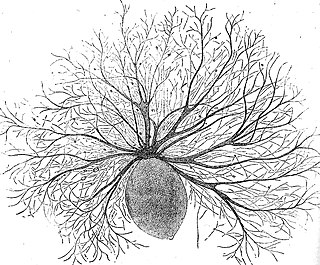
Velvet disease is a fish disease caused by dinoflagellate parasites of the genus Piscinoodinium, specifically Amyloodinium in marine fish, and Oodinium in freshwater fish. The disease gives infected organisms a dusty, brownish-gold color. The disease occurs most commonly in tropical fish, and to a lesser extent, marine aquaria.
Sparganosis is a parasitic infection caused by the plerocercoid larvae of the genus Spirometra including S. mansoni, S. ranarum, S. mansonoides and S. erinacei. It was first described by Patrick Manson from China in 1882, and the first human case was reported by Charles Wardell Stiles from Florida in 1908. The infection is transmitted by ingestion of contaminated water, ingestion of a second intermediate host such as a frog or snake, or contact between a second intermediate host and an open wound or mucous membrane. Humans are the accidental hosts in the life cycle, while dogs, cats, and other mammals are definitive hosts. Copepods are the first intermediate hosts, and various amphibians and reptiles are second intermediate hosts.

The New Zealand mud snail is a species of very small freshwater snail with a gill and an operculum. This aquatic gastropod mollusk is in the family Tateidae.

Dracunculus medinensis, or Guinea worm, is a nematode that causes dracunculiasis, also known as guinea worm disease. The disease is caused by the female which, at up to 80 centimetres in length, is among the longest nematodes infecting humans. In contrast, the longest recorded male Guinea worm is only 4 cm.
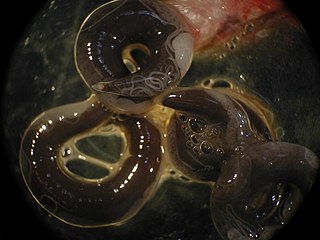
Anguillicoloides crassus is a parasitic nematode worm that lives in the swimbladders of eels and appears to spread easily among eel populations after introduction to a body of water. It is considered to be one of the threats to the sustainability of populations of European eel. It was introduced to the European continent in the 1980s, where it was reported independently from Germany and Italy in 1982, having probably been introduced from Taiwan. It is thought to have reached England in 1987 from continental Europe. It is a natural parasite of the Japanese eel in its native range.

Diel vertical migration (DVM), also known as diurnal vertical migration, is a pattern of movement used by some organisms, such as copepods, living in the ocean and in lakes. The migration occurs when organisms move up to the uppermost layer of the sea at night and return to the bottom of the daylight zone of the oceans or to the dense, bottom layer of lakes during the day. The word diel comes from the Latin dies day, and means a 24-hour period. In terms of biomass, it is the greatest migration in the world. It is not restricted to any one taxon as examples are known from crustaceans (copepods), molluscs (squid), and ray-finned fishes (trout). Various stimuli are responsible for this phenomenon, the most prominent being response to changes in light intensity, though evidence suggests that biological clocks are an underlying stimulus as well. The phenomenon may arise for a number of reasons, though it is most typically to access food and avoid predators. While this mass migration is generally nocturnal, with the animals ascending from the depths at nightfall and descending at sunrise, the timing can be altered in response to the different cues and stimuli that trigger it. Some unusual events impact vertical migration: DVM is absent during the midnight sun in Arctic regions and vertical migration can occur suddenly during a solar eclipse.
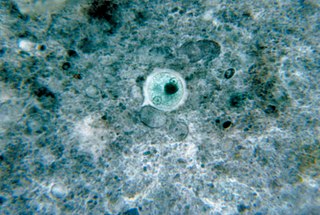
A microbial cyst is a resting or dormant stage of a microorganism, usually a bacterium or a protist or rarely an invertebrate animal, that helps the organism to survive in unfavorable environmental conditions. It can be thought of as a state of suspended animation in which the metabolic processes of the cell are slowed and the cell ceases all activities like feeding and locomotion. Encystment, the formation of the cyst, also helps the microbe to disperse easily, from one host to another or to a more favorable environment. When the encysted microbe reaches an environment favorable to its growth and survival, the cyst wall breaks down by a process known as excystation. In excystment, the exact stimulus is unknown for most protists.
Schistocephalus solidus is a tapeworm of fish, fish-eating birds and rodents. This hermaphroditic parasite belongs to the Eucestoda subclass, of class Cestoda. This species has been used to demonstrate that cross-fertilization produces a higher infective success rate than self-fertilization.
Acartia hudsonica is a species of marine copepod belonging to the family Acartiidae. Acartia hudsonica is a coastal, cold water species that can be found along the northwest Atlantic coast.
Diphyllobothrium mansonoides is a species of tapeworm (cestodes) that is endemic to North America. Infection with D. mansonoides in humans can result in sparganosis. Justus F. Mueller first reported this organism in 1935. D. mansonoides is similar to D. latum and Spirometra erinacei. When the organism was discovered, scientist did not know if D. mansonoides and S. erinacei were separate species. PCR analysis of the two worms has shown the two to be separate but closely related organisms.
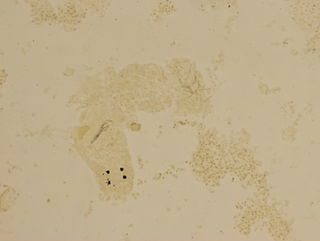
Dactylogyrus vastator is a species of hermaphroditic flatworms of class Monogenea. It is an ectoparasite of fish which infests the gills. It is problematic on fish farms. It is otherwise non-hazardous to humans.
Syndinium is a cosmopolitan genus of parasitic dinoflagellates that infest and kill marine planktonic species of copepods and radiolarians. Syndinium belongs to order Syndiniales, a candidate for the currently uncultured group I and II marine alveolates. The lifecycle of Syndinium is currently not well understood beyond the parasitic and zoospore stages.
Bothriocephalus acheilognathi, also known as the Asian tapeworm, is a freshwater fish parasite that originated from China and Eastern Russia. It is a generalized parasite that affects a wide variety of fish hosts, particularly cyprinids, contributing to its overall success.

Spongilla lacustris, also commonly referred to as freshwater sponge, is a species of sponges from the family Spongillidae. They inhabit freshwater rivers and lakes, often growing under logs or rocks. Lacustris is a Latin word meaning "related to or associated with lakes". The species ranges from North America to Europe and Asia. It is the most common freshwater sponge in central Europe. It is the most widespread sponge in Northern Britain, and is one of the most common species of sponges in lakes and canals. Spongilla lacustris have the ability to reproduce both sexually and asexually. They become dormant during winter. The growth form ranges from encrusting, to digitate, to branched, depending upon the quality of the habitat.
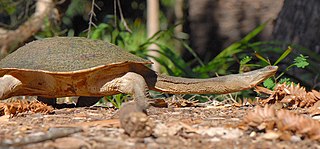
Chelodina (Chelydera) expansa, commonly known as the broad-shelled river turtle or the broad-shelled snake-necked turtle, is a pleurodiran freshwater turtle and is the largest of the long-necked turtles. The broad-shelled river turtle is one of the oldest-maturing and longest-living species of freshwater turtles in existence and occurs in wide sympatry with Emydura macquarii and Chelodina longicollis. C. expansa is listed as ‘vulnerable’ in South Australia and ‘threatened’ in Victoria.

Lepidurus apus, commonly known as a tadpole shrimp, is a notostracan in the family Triopsidae, one of a lineage of shrimp-like crustaceans that have had a similar form since the Triassic period and are considered living fossils. This species is cosmopolitan, inhabiting temporary freshwater ponds over much of the world, and the most widespread of the tadpole shrimps. Like other notostracans, L. apus has a broad carapace, long segmented abdomen, and large numbers of paddle-like legs. It reproduces by a mixture of sexual reproduction and self-fertilisation of females.
Blastodinium is a diverse genus of dinoflagellates and important parasites of planktonic copepods. They exist in either a parasitic stage, a trophont stage, and a dinospore stage. Although morphologically and functionally diverse, as parasites they live exclusively in the intestinal tract of copeods.
Eucalanus bungii is a copepod found in the north Pacific and surrounding waters.











